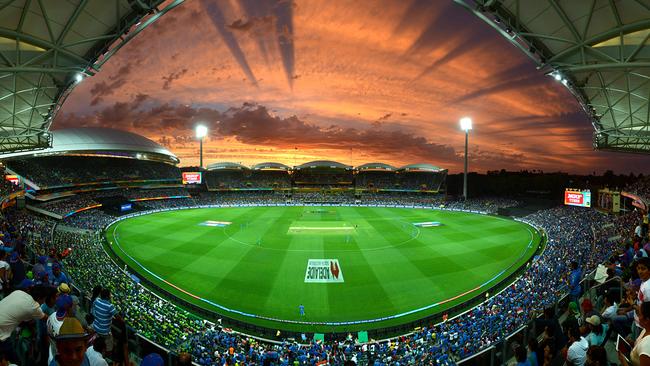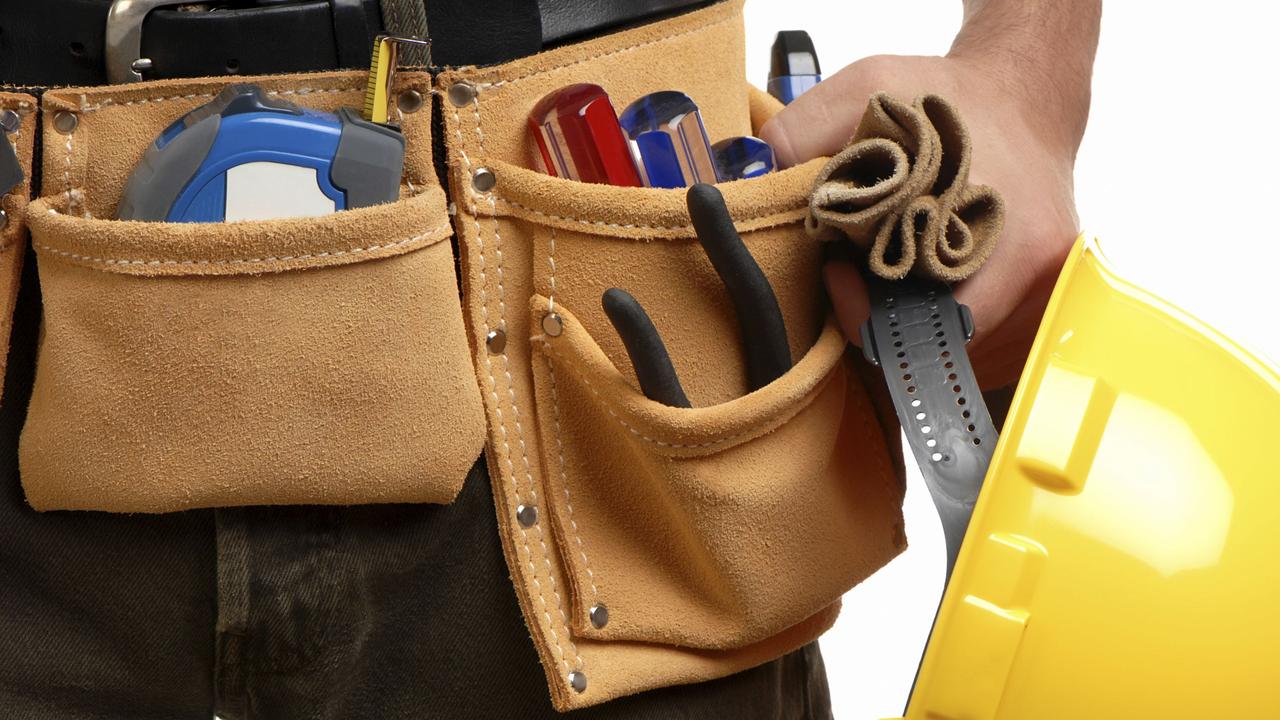Secrets to Adelaide Oval redevelopment revealed
FORMER treasurer Kevin Foley ambushed his premier with secret plans for an Adelaide Oval upgrade — in one of several close calls that could have sunk the project. SPECIAL FEATURE: How the deal was done
SA News
Don't miss out on the headlines from SA News. Followed categories will be added to My News.
FORMER treasurer Kevin Foley ambushed his premier with secret plans for an Adelaide Oval upgrade in one of a series of moments when the now widely acclaimed upgrade almost collapsed forever, it can be revealed.
Even after the historic deal to unite cricket and football at the Oval had been revealed in 2009, the $535 million project was almost scuppered by numerous disputes, including a push to play cricket at AAMI Stadium in West Lakes.
SPECIAL FEATURE BELOW: How the deal was done
The Advertiser has spoken to several powerbrokers at the heart of the Rann Labor government, who have divulged the inside story of the brutal politics behind the extremely successful Oval upgrade.
On the eve of the 2015 AFL season start at the Oval, these powerbrokers detail clandestine Adelaide and Melbourne meetings, only some details of which have been revealed to the public.
It is understood Mr Foley acted as a lone wolf for some months in late 2008 and early 2009, conducting secret talks with then AFL chief Andrew Demetriou and South Australian Cricket Association president Ian McLachlan.
In the wake of the global financial crisis, he obtained Cabinet approval to unilaterally scrap projects worth $100 million or less. Mr Foley then used this to ditch $100 million plans to upgrade AAMI Stadium, telling only his premier, Mike Rann, in advance.
He ambushed Mr Rann in early 2009 at a Melbourne meeting with AFL officials by masking it as a meet and greet, yet unveiled concept plans and early financials for the Oval upgrade.
A furious Mr Rann is said to have accused Mr Foley of “rat-f***ing” him but, crucially, was convinced of the project’s merits, as was the other member of the trio then running state Labor, Infrastructure Minister Patrick Conlon.
Football and cricket leaders subsequently sealed a deal and demonstrated this to Mr Rann at an after-hours meeting in the Cabinet room in late 2009.
But the project almost fell apart several times after the deal was announced that December, and Mr Conlon took over responsibility in 2010.
A condition of the deal by sports leaders was that the Adelaide City Council be frozen out of talks.
The SANFL pushed for cricket to be played at AAMI Stadium to free up Adelaide Oval as an unimpeded construction site. But Government powerbrokers argued that banning cricket during this time would have killed support from the cricket community. They now believe this view has been vindicated.
In a further hitch, successful contractor Baulderstone (now Lend Lease) was the only one of three bidders able to complete the project within the specified time frame.
A concession of a 70 per cent public transport use target for patrons was required to get the project through the Upper House.
Even towards the project’s end, an AFL contract was interpreted as giving the league approval and veto powers over future Oval works and management, so the Government refused to sign.

How did the mega deal came together
By Paul Starick
MOST people would be happy when told about a $100 million gift. At least that’s what Treasurer Kevin Foley would have thought, at first, when he called AFL chief executive Andrew Demetriou in mid-2008 to detail the State Government’s pledge for an upgrade of AAMI Stadium at West Lakes.
Rather than welcome the financing of the stadium’s upgrade to international standards, Demetriou spluttered at the Labor government’s move. The SANFL-owned stadium was dilapidated and out of the way, he told Foley.
Initially surprised, Foley was reminded of an AFL government relations officer meeting in 2007 with his then chief of staff, Stephen Mullighan, now SA’s Transport Minister.
Then, the AFL had been testing the water about a possible return of top-level football to Adelaide Oval, a prospect which had been pushed by the South Australian Cricket Association since 1995 under various guises.
Public pressure had been mounting for almost two years for a city stadium to replace AAMI Stadium, formerly Football Park. An AFL preliminary final between Adelaide and West Coast at AAMI in September, 2006, had been the trigger point for an Advertiser campaign aimed at securing a modern stadium in the city’s heart.
Then Liberal opposition leader Martin Hamilton-Smith in February 2008 had revealed plans for a new world-class, multi-sport stadium on the city’s western edge.
Almost in the background at the same time, SACA’s ambitious plan for a western grandstand redevelopment at the Oval was hitting financial and Adelaide City Council approval hurdles. Ultimately, SACA president Ian McLachlan’s foresight in spearheading this upgrade and securing funds laid the foundation for the acclaimed Oval design and unstoppable momentum for AFL games.
FOLEY’S LEAP OF FAITH
But the realisation that the AFL’s boss wanted AFL at Adelaide Oval set Foley, in the words of a former colleague, “off the reservation”. The Treasurer decided to act, without the knowledge of then premier Mike Rann or his Cabinet colleagues.
A series of meetings followed with Demetriou, McLachlan and AFL chairman Mike Fitzpatrick. The first two, along with Foley, are widely credited with laying the foundations to end the bitter 40-year feud between football and cricket to reunite them at the Oval.
Then the global financial crisis hit. The Labor Cabinet rapidly axed projects to ease debt, including a $770 million new prison complex at Mobilong. In late October, 2008, Foley secured Cabinet approval to unilaterally scrap projects worth $100 million or less.
Foley moved alone on the AAMI Stadium upgrade, calling SANFL chief Leigh Whicker to tell him he was taking away the $100 million. Foley told Rann in advance but not other Cabinet colleagues.
The clandestine push for an Adelaide Oval upgrade intensified. Foley arranged a meeting in Melbourne with Rann and Demetriou in early 2009, under the pretence of a meet and greet.
But the Premier was ambushed, confronted with the early fruits of his Treasurer’s dalliance with cricket and the AFL. Rann was shown plans, commissioned by SACA at the AFL’s behest in April, for an upgraded Adelaide Oval.
Initially, the ambush backfired. Rann did not like surprises. He was said to have been furious at Foley for having gone behind his back and accused him of “ratf ... ing” him. The 2010 state election was less than a year away and Rann did not want to provoke a fight with the powerful SANFL, which was determined to upgrade West Lakes, and the state’s biggest AFL club, the Adelaide Crows.
Rann had to be convinced of the policy and the politics.
The other member of the trio atop the State Government, Infrastructure Minister Patrick Conlon, also had to be brought into the loop and convinced. In April, the ice started to thaw, as SACA and the SANFL met in Melbourne for AFL-brokered talks.
HIDING BEHIND THE PILLAR
Foley continued the clandestine meetings with the AFL.
On April 5, an hour before West Coast played his beloved Port Adelaide at AAMI, Foley had arranged a meeting with Demetriou and his chief operating officer Gillon McLachlan at his apartment just across the lake, on Delfin Island.
The AFL duo were being taken around Adelaide by Whicker’s driver and did not want to divulge their meeting with Foley. As they were dropped off, Foley hid behind a pillar. Demetriou and McLachlan talked among themselves until the driver left, when Foley suddenly popped out. The AFL pair walked in front of him to maintain the ruse. It was not until later that the trio realised Whicker’s driver knew it was Foley’s home anyway.
By mid-2009, the prospect of a major Adelaide Oval upgrade was splashed across The Advertiser’s front page. On July 25, SACA chief executive Mike Deare revealed a $350 million plan to upgrade Adelaide Oval to secure AFL matches from 2014. Foley had already raised the possibility of switching the $100 million earmarked for AAMI to Adelaide Oval.
Foley has said Demetriou “took the primary role in getting the SANFL to see sense” and revealed the AFL would have switched Port Adelaide to the Oval regardless of whether the SANFL came on board.
But Demetriou has said a lunch at Pulteney St’s Alphutte Restaurant in late 2009 with Whicker and former SANFL president Max Basheer was the critical turning point.
This resulted in all the key players — SANFL, AFL and SACA — walking into the state Cabinet room after hours in late 2009, to prove to Rann they could seal the historic deal.
Revamped Oval in all its glory
ON THE CUSP OF HISTORY
There was some disquiet in Cabinet about how Foley could find hundreds of millions for an Oval upgrade, but not for schools, hospitals or roads. But Rann, Conlon and other senior ministers were supportive.
“I don’t reckon it would have happened if Kevin hadn’t been Treasurer. It was the best and worst of Kevin,” one of his senior colleagues told The Advertiser.
“Instead of having to ask the Treasurer for ridiculous money, even without going to Cabinet, he’d decided he wanted it to go ahead.”
On December 2, 2009, Rann announced the state would commit $450 million to the upgrade, branding Adelaide Oval “an icon of this city and this state”.
History had been made. The war between cricket and football was over but plenty of battles ahead almost scuppered the project.
WHY THE PROJECT NEARLY FELL OVER
Foley, Demetriou and McLachlan were the catalysts but the responsibility of delivering the vision fell to Infrastructure Minister Patrick Conlon and his right-hand man, Rod Hook, the major projects director in his department.
Labor had taken a $450 million Oval budget to the March, 2010 election. This included $85 million to SACA to buy out its lease and effectively write down its debt.
This left $375 million for the project, including increasing the Oval’s capacity to more than 50,000 people.
A target of $12,000 per seat was set and it quickly became apparent the Budget needed to be revisited.
A political storm erupted. Foley was accused of misleading Parliament for forgetting to report a briefing concerning an $85 million project blowout a fortnight before the election.
The Government had to produce the extra money to enable the project to go ahead but had to concede a public expenditure cap at $535 million and six-monthly project reports by the Auditor-General.
FREEZE OUT THE COUNCIL
The Oval was leased by the Adelaide City Council to the SACA. The Government needed to gain control for the project to proceed. None of the sports groups wanted to deal with the council.
Conservative elements on the council were blamed for wrecking plans for a permanent grandstand at Victoria Park for the Clipsal 500 race. The key players at Adelaide Oval did not want a repeat.
Conlon handled the politics, including the council talks. Among the concessions required to get the legislation through the Upper House was a public transport target. At AAMI Stadium, a maximum of about 20 per cent of patrons used the free Footy Express buses. Conlon won Greens support by writing into the legislation a 70 per cent public transport target.
CLUB CHIEFS THREATEN TO WALK
Behind the scenes, the whole project was still under threat. Conlon met with SANFL club chiefs, who had not been involved in the talks and were threatening to walk. Laying his cards on the table, he asked whether they wanted to stop the project and whether it was worthwhile continuing. Eventually, the SANFL was satisfied with the now-actioned plans to sell off AAMI for housing and pump the proceeds into an SA footy Future Fund.
But the SANFL was adamant that it negotiated for SA footy and the Government was not supposed to deal with either the Adelaide or Port Adelaide football clubs.
All sides concede tensions throughout the talks brought the project to the brink of collapse several times.
In a bid to defuse any concerted campaign, Conlon met with sporting and political powerbroker Rob Gerard over lunch at Enzo’s Ristorante on Port Rd. He sought and secured an assurance that the wealthy Crows fan and Liberal donor would not be involved with any campaign against the Oval.
But the biggest showstopper came in February, 2011, when football and cricket were locked in a power-sharing row. Neither would bow to a sublease to the newly-formed Stadium Management Authority. Football wanted to control its destiny. On a Saturday morning, Conlon, a lawyer, came up with the idea of legislation which guaranteed football and cricket’s rights in a separate licence agreement.
“I hate to burden people with a gift of visualisation but the solution to the problem came to me in the shower one Saturday morning,” Conlon has said.
Another major hurdle arose when only one of the three contractors which submitted for the project said they could prepare the Oval for the Ashes Test in December 2013, and have it ready for the 2014 AFL season. Baulderstone (now Lend Lease) also bid the lowest price and was awarded the contract in October, 2011.
GALLERY: A year of milestones for Adelaide Oval
CRICKET AT AAMI?
Meanwhile, the SANFL was pushing for cricket to be played at AAMI Stadium so Adelaide Oval would be an unimpeded construction site.
“Our view was that to ban cricket from Adelaide during the construction period would kill off support from the cricket community,” one project powerbroker told The Advertiser.
Having driven the project, the AFL was now proving tricky over its $5 million contribution. The Government wanted more money but understood this was the best they would get.
Initially, the AFL offered to pay half in March, 2014 and the remainder on June 30. The Government said this was unacceptable because the project’s funding cap meant it could not effectively borrow money.
Hook also interpreted the AFL’s funding contract as giving approval and veto powers over future works and management measures at the Oval. The Government pointed out that the AFL’s financial contribution was small and refused to sign. The AFL relented.
A minor wrangle ensued with football and the Stadium Management Authority over whether the Government should pay for electronic advertising signs. The Government insisted the SANFL pay and the AFL wanted the Government to pay. Eventually, football paid. Power struggles ensued between the SMA — representing the sports — and the Government. This was viewed within Government as a threat to its right to manage the contract. There were said to be numerous occasions in which sports representatives asked Baulderstone for construction changes without involving government.
FIGHTS TO THE FINISH
The internecine wrangling continued right up to the first AFL game at the redeveloped Oval in March, 2014.
Football and cricket representatives eyed off the configuration, finishes and furniture in the rooms which were being built for one another. If one was perceived to be gaining the upper hand, they approached contractors for extra facilities. Project managers had to reinforce the existing agreements.
The handover from Lend Lease to the Stadium Management Authority had to be brought forward by five days to have the Oval ready for a Rolling Stones concert, which was subsequently postponed.
SMA chief Andrew Daniels also said it gave more time to access the stadium ahead of the concert and the football season. But it also forced delay to works including weatherproofing the western grandstand, some landscaping and the northern car park. Ironically, works in the north parklands will prevent car parking there this season.
But it did not prevent the first AFL match at the upgraded Oval on March 29 last year. The triumph of Adelaide Oval’s redevelopment quickly became apparent. It has been embraced and acclaimed globally, hosting football, cricket, soccer and other major events.
It was a long and thorny path but, on the eve of the 2015 AFL season, Adelaide Oval is, as Rann said, an icon of this city and this state.



